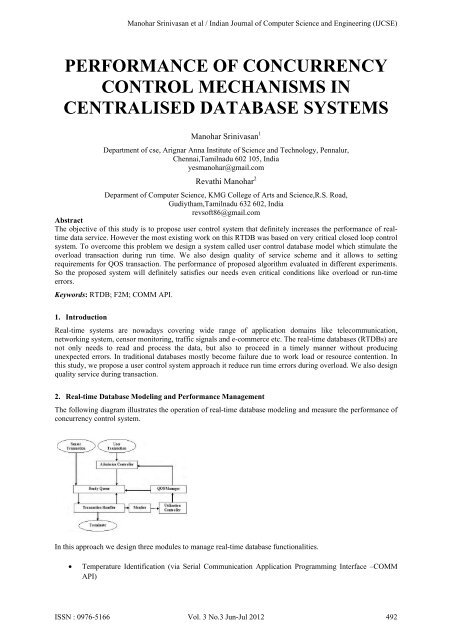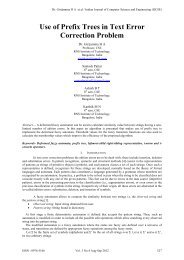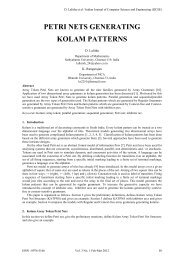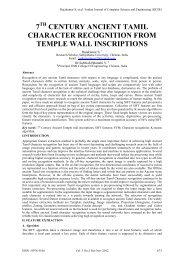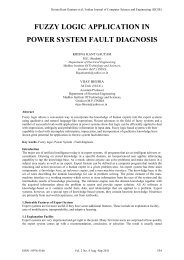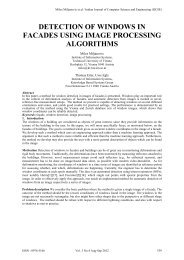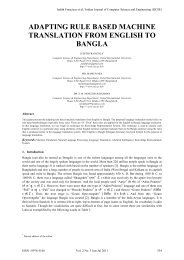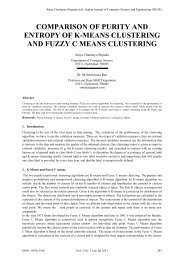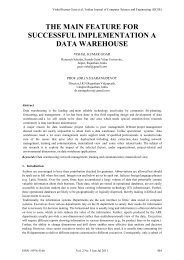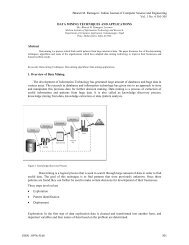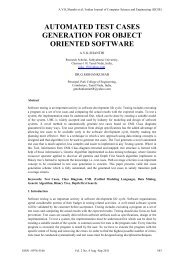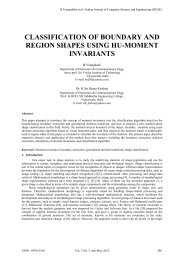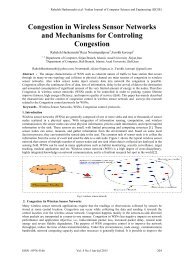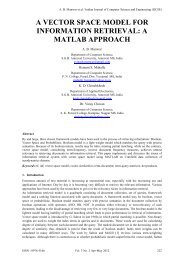performance of concurrency control mechanisms in centralised ...
performance of concurrency control mechanisms in centralised ...
performance of concurrency control mechanisms in centralised ...
Create successful ePaper yourself
Turn your PDF publications into a flip-book with our unique Google optimized e-Paper software.
Manohar Sr<strong>in</strong>ivasan et al / Indian Journal <strong>of</strong> Computer Science and Eng<strong>in</strong>eer<strong>in</strong>g (IJCSE)PERFORMANCE OF CONCURRENCYCONTROL MECHANISMS INCENTRALISED DATABASE SYSTEMSManohar Sr<strong>in</strong>ivasan 1Department <strong>of</strong> cse, Arignar Anna Institute <strong>of</strong> Science and Technology, Pennalur,Chennai,Tamilnadu 602 105, Indiayesmanohar@gmail.comRevathi Manohar 2Deparment <strong>of</strong> Computer Science, KMG College <strong>of</strong> Arts and Science,R.S. Road,Gudiytham,Tamilnadu 632 602, Indiarevs<strong>of</strong>t86@gmail.comAbstractThe objective <strong>of</strong> this study is to propose user <strong>control</strong> system that def<strong>in</strong>itely <strong>in</strong>creases the <strong>performance</strong> <strong>of</strong> realtimedata service. However the most exist<strong>in</strong>g work on this RTDB was based on very critical closed loop <strong>control</strong>system. To overcome this problem we design a system called user <strong>control</strong> database model which stimulate theoverload transaction dur<strong>in</strong>g run time. We also design quality <strong>of</strong> service scheme and it allows to sett<strong>in</strong>grequirements for QOS transaction. The <strong>performance</strong> <strong>of</strong> proposed algorithm evaluated <strong>in</strong> different experiments.So the proposed system will def<strong>in</strong>itely satisfies our needs even critical conditions like overload or run-timeerrors.Keywords: RTDB; F2M; COMM API.1. IntroductionReal-time systems are nowadays cover<strong>in</strong>g wide range <strong>of</strong> application doma<strong>in</strong>s like telecommunication,network<strong>in</strong>g system, censor monitor<strong>in</strong>g, traffic signals and e-commerce etc. The real-time databases (RTDBs) arenot only needs to read and process the data, but also to proceed <strong>in</strong> a timely manner without produc<strong>in</strong>gunexpected errors. In traditional databases mostly become failure due to work load or resource contention. Inthis study, we propose a user <strong>control</strong> system approach it reduce run time errors dur<strong>in</strong>g overload. We also designquality service dur<strong>in</strong>g transaction.2. Real-time Database Model<strong>in</strong>g and Performance ManagementThe follow<strong>in</strong>g diagram illustrates the operation <strong>of</strong> real-time database model<strong>in</strong>g and measure the <strong>performance</strong> <strong>of</strong><strong>concurrency</strong> <strong>control</strong> system.In this approach we design three modules to manage real-time database functionalities.• Temperature Identification (via Serial Communication Application Programm<strong>in</strong>g Interface –COMMAPI)ISSN : 0976-5166 Vol. 3 No.3 Jun-Jul 2012 492
Manohar Sr<strong>in</strong>ivasan et al / Indian Journal <strong>of</strong> Computer Science and Eng<strong>in</strong>eer<strong>in</strong>g (IJCSE)• Adm<strong>in</strong> Control• User Control2.1. Temperature Identification and TransmissionIn this module we are go<strong>in</strong>g to get the temperature as an <strong>in</strong>put for our real-time database. This <strong>in</strong>put is gett<strong>in</strong>gfrom the F2M (female-to-male) cable and it is transmitted to the adm<strong>in</strong> <strong>control</strong>. For this <strong>in</strong>put transmission weare us<strong>in</strong>g serial communication Java API i.e (COMM API).This temperature <strong>in</strong>put will store the current <strong>in</strong>put <strong>in</strong>to the database as well as update it <strong>in</strong>to the adm<strong>in</strong><strong>control</strong>ler.2.2. Adm<strong>in</strong> ControlIn adm<strong>in</strong> <strong>control</strong> module we are go<strong>in</strong>g to monitor the temperature as <strong>in</strong>put, and it <strong>control</strong> the request from users.The temperature <strong>in</strong>put is updated <strong>in</strong>to the database as well as the output is monitor <strong>in</strong>to the adm<strong>in</strong> contrl asplotted graphs concurrently.When the users sends request for that temperature, first we ma<strong>in</strong>ta<strong>in</strong> a queue for that requests. That the queue isaltered based on the success ratio. We also provide utilization <strong>control</strong>ler for improv<strong>in</strong>g success ratio. Then theuser gets the output temperature as plotted graphs.2.3. User ControlIn this user <strong>control</strong> module the user will receive the output plotted graphs for current temperature. The user sendrequest to adm<strong>in</strong> <strong>control</strong> for gett<strong>in</strong>g temperature request. Also the user <strong>control</strong> will get plotted graphs at specificperiod <strong>of</strong> tim<strong>in</strong>g <strong>in</strong>terval.3. Measurement <strong>of</strong> QoSWe also design quality <strong>of</strong> service (QoS) management scheme that allows the sett<strong>in</strong>g <strong>of</strong> several QoSrequirements for transaction <strong>of</strong> equal importance is proposed. The <strong>performance</strong> <strong>of</strong> the proposed algorithm isevaluated <strong>in</strong> s different experiments. This simulation studies show that the proposed solution satisfies therequirements even dur<strong>in</strong>g overloads and <strong>in</strong>accurate run-time estimation errors. We show that our approach canexpect the desire output and considerably enhanc<strong>in</strong>g the success ratio.The success ratio is def<strong>in</strong>ed as follows:SR = 100 × (N timely / N submitted ) (%)N timely is the number <strong>of</strong> transactions committed before their deadl<strong>in</strong>es andN submitted is the total number <strong>of</strong> transactions submitted to the RTDB.4. Future ExtractionMulti version <strong>concurrency</strong> <strong>control</strong> mechanism could reduce data conflicts <strong>in</strong> RTDBs. This <strong>in</strong>vestigation isreserved for future work.References[1] Mr. Jisu Oh and Mr. Kyoung-Don Kang: “An Approach for Real-time Database Model<strong>in</strong>g and Performance Management”, 13 th IEEEReal Time Technology and Application Symposium 2007.[2] R. Abbott and H. Garcia-Mol<strong>in</strong>a: “Schedul<strong>in</strong>g Real-Time Transaction: A Performance Evaluation ACM Transaction on DatabaseSystem”,17:513-560,1992[3] Nicolas Chaufette: “Generalized Performance Management <strong>of</strong> Multi Class Real-Time Imprecise Data Services”, June 5, 2006[4] Mehdi Amirijoo, Jorgen Hansson: “Specification and Management <strong>of</strong> QoS <strong>in</strong> Real Time Databases Support<strong>in</strong>g ImpreciseComputations”, March 2006.[5] Jayant R. Haritsa, Micheal J. Carey, and Miron Livny: “Value based Schedul<strong>in</strong>g <strong>in</strong> Real-Time Database System”, Oct 6 1992.[6] Piotr Krzyzagorski, “Concurrency Control <strong>in</strong> Real-Time Database Systems”, 2000.[7] Chenyang Lu, John A Stankovic, Tarek F. Abdelzaher, Gang Tao, Sang H. Son and Michael Marley, “Performance Specifications andMetrics for Adaptive Real-Time Systems” December 2000.ISSN : 0976-5166 Vol. 3 No.3 Jun-Jul 2012 493


